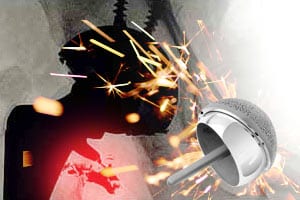
Although metal-on-metal hip implant devices were created for greater durability and longevity over traditional implants constructed with plastic or ceramic components, the metal devices are failing at high and unexpected rates. In response to mounting adverse event reports, litigation, and recalls, the U.S. Food & Drug Administration (FDA) says that the devices can lead to […]
 Although metal-on-metal hip implant devices were created for greater durability and longevity over traditional implants constructed with plastic or ceramic components, the metal devices are failing at high and unexpected rates.
Although metal-on-metal hip implant devices were created for greater durability and longevity over traditional implants constructed with plastic or ceramic components, the metal devices are failing at high and unexpected rates.
In response to mounting adverse event reports, litigation, and recalls, the U.S. Food & Drug Administration (FDA) says that the devices can lead to pain, soft tissue damage, and metal shedding in the area where the device’s components meet—typically at the ball and cup junction, said FoxNews. Metal shedding can occur when the device’s socket is in normal use, such as during walking or running.
The device defect has led to the need for revision surgery in many metal-on-metal patients. Surgery involves removal of the defective device and replacement with a different device. This re-implantation is a longer and more complicated procedure that original implant procedures.
The agency says surgeons should review the risks versus the benefits of metal-on-metal devices and should ensure those benefits outweigh the benefits of other, non-metal systems when considering patient surgery, noted FoxNews.
The first-of-its-kind announcement by the FDA is an update to existing agency safety information and recommendations and, said Medscape, involved a review of the devices based on the agency’s review of published studies and findings from its Orthopedic and Rehabilitation Advisory Panel.
Metal-on-metal hip devices prompted a massive debacle that included serious adverse reaction reports, global recalls, and regulatory and medical probes. Some experts say that European and American regulators worked to ensure patients were unaware of the devices’ risks, said Medscape.
Research has linked metal-on-metal hip devices to adverse events that include tissue necrosis, implant site pain that can spread to the groin and back, inflammation, swelling, metal poisoning, high failure rates, osteolysis (bone loss), and fluid collection/solid mass development around the hip joint. More-and-more, reports and research indicates that some patients have had to undergo painful re-implantation just two or three years following original surgery.
Typical wear and tear on the implants’ metal ball and cup, or other implant parts in which two components connect, appears to release metal into patients’ bodies, which can damage surrounding bone and soft tissue. This “metallosis” may lead to pain, loosening of the device or device failure, and the need for revision surgery. Should the metal ions enter the bloodstream and reach other organs, other adverse reactions such as skin rash, cardiomyopathy, and renal function impairment, have been reported, according to Medscape.
From a legal standpoint, these changes are considered significant when attempting to hold manufacturers responsible for dangers associated with their products.


